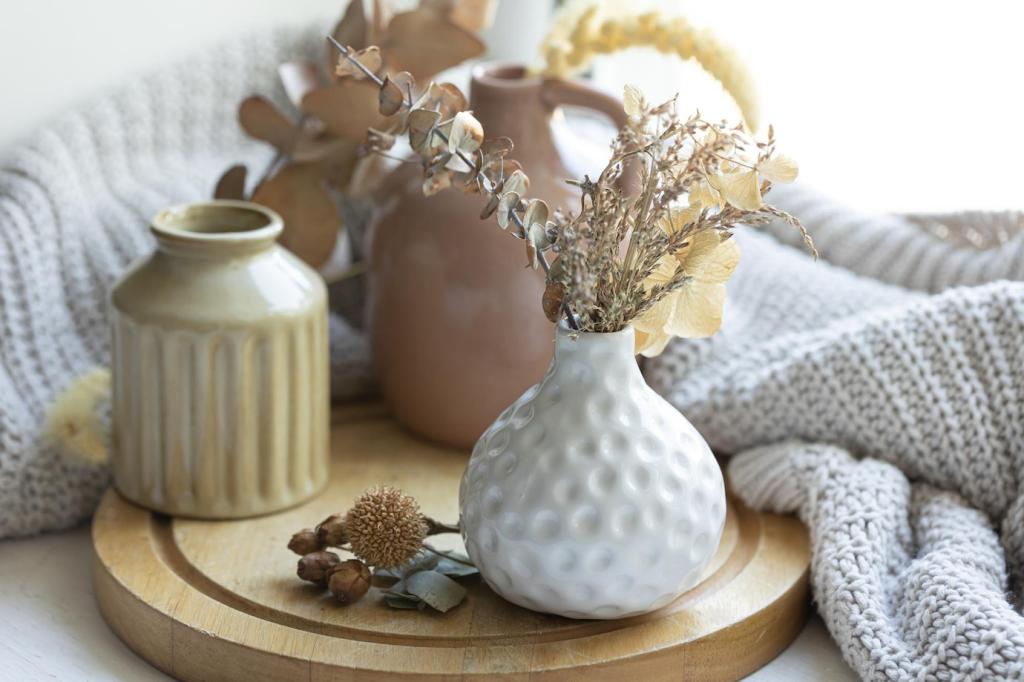Sustainably Produced Ceramics: Beauty with a Smaller Footprint
Why Sustainable Ceramics Matter
01
Every piece begins as earth and ends as an object that might outlast us. Sustainably produced ceramics consider extraction, transport, and firing energy, choosing lower-impact paths without sacrificing beauty, function, or the quiet joy that good pottery brings daily.
02
A cheap mug can carry hidden costs: carbon from long shipping, toxic glaze waste, and underpaid labor. Sustainably produced ceramics reveal those costs, then cut them, creating durable pieces that spread impact across decades of breakfasts, conversations, and shared kitchens.
03
When Mara tallied her kiln’s energy use, she felt uneasy. She switched to shared firings, lowered her cone, and tracked savings. Her cups still sing on the table, now with a lighter footprint. What change could your daily ritual inspire?
Materials and Sourcing with Integrity
Choosing regional clay lowers transport emissions and strengthens community knowledge. Potters who publish mine locations and testing results make trust tangible. Ask makers about their clay bodies, blends, and why those choices suit both performance and environmental stewardship.


Materials and Sourcing with Integrity
Crushed, fired scraps can become recycled grog, reinforcing clay while diverting broken tests from landfill. Sustainably produced ceramics treat failed pieces as future strength, closing loops that keep texture lively and reduce the need for fresh, energy-intensive materials.
Energy-Smart Firing and Kiln Strategies
Lower-Temperature Mastery
Cone 5–6 stoneware and beautiful midfire glazes can cut energy compared to higher cones, especially in electric kilns. Mature strength, vibrant surfaces, and reduced kilowatt-hours show that performance and sustainability can coexist without compromising a potter’s creative voice.
Renewable-Powered Studios
Studios pairing electric kilns with rooftop solar or community solar credits shrink firing emissions substantially. Timers align kiln ramps with sunny hours, while insulation maintenance prevents heat leaks. Share your renewable wins so others can adapt similar solutions affordably.
Community Kiln Schedules
Batching work and coordinating firings with nearby makers maximizes kiln loads, lowering per-piece energy. Sustainably produced ceramics thrive on collaboration: pooled firings, shared thermocouples, and rotating tech support make efficiency a habit rather than an occasional experiment.


Designing Ceramics for Longevity
Classic profiles resist trends and remain loved as kitchens change. Balanced handles, stable bases, and lip-friendly rims keep pieces in rotation. When design endures, the embodied energy is honored daily, not forgotten at the back of a crowded cupboard.
Designing Ceramics for Longevity
Stressing handles, rims, and junctions during prototyping reveals weak points. Thickening gracefully, refining attachments, and testing thermal shock create resilient pieces. Sustainably produced ceramics survive dishwashers, hot tea, and busy mornings without cracking under the pressure of real life.
Buckets capture trimmings and slop; time and patience return them to workable clay. Labeling, sieving, and wedging turn yesterday’s offcuts into tomorrow’s vessels. This simple practice saves money, reduces landfill waste, and keeps mud where it belongs—on the wheel.

Fair Work and Community-Centered Making
Transparent pricing reflects materials, energy, and skilled labor, ensuring livelihoods without exploitation. When potters are paid fairly, sustainability becomes possible, not performative. Buyers become partners, investing in craft that respects hands, time, and the communities that nurture them.
Open studio hours, tool libraries, and workshops pass skills forward. Sustainably produced ceramics grow through generosity, where troubleshooting kiln logs and glaze data helps everyone waste less. Share what you wish you had learned earlier to lift new makers.
Working with regional materials connects objects to place. Community markets and guilds keep value circulating locally. When buyers meet makers, repair becomes easier, stories deepen, and the environmental cost of shipping shrinks alongside the emotional distance between hands.
Choosing and Caring for Sustainable Pieces
Ask about clay sourcing, firing temperature, glaze safety, and packaging. Makers who track these details usually design for durability too. Your questions signal demand for transparency and encourage studios to document and improve their sustainability efforts over time.
Choosing and Caring for Sustainable Pieces
Avoid thermal shock, use gentle detergents, and store pieces so rims do not grind. Small habits keep surfaces smooth and bright. Sustainably produced ceramics reward care with decades of dependable service, turning routines into tiny rituals worth savoring.


